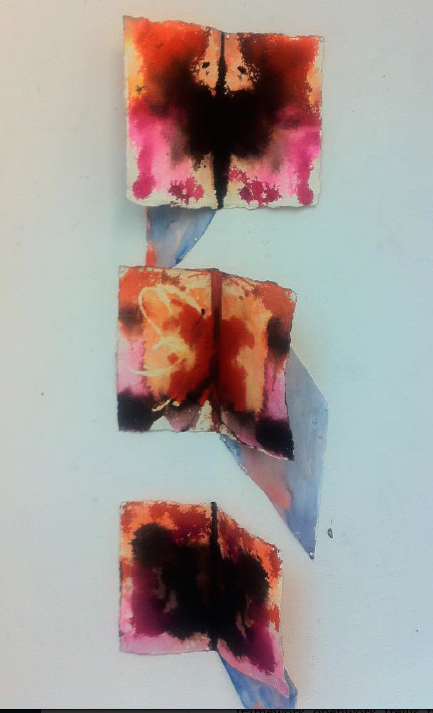pampam.mp3 (2010)
“My paintings reflect how I perceive nature to paint, something I am able to see when I look at the sky at night and read the random shapes and patterns in the heavens, her preferred canvas.” - Pam Jennings
This piece was composed for a collaborative performance project with Pam Jennings, who is an artist, psychologist, and psychoanalyst. Many of her paintings are elaborated by chance. Jennings applies particular process, such as taking advantage of gravity, multiple drying, and evaporation. While working as a clinical psychoanalyst, she was inspired by the Rorschach test. Pam uses watercolor on absorbent paper to produce found color by repeating the procedure numerous times to pick up the best one.
These three paintings to the right were in her studio at Brooklyn College, where we first met and brainstormed for the collaborative project. I was inspired by her idea of taking advantage of the chance for making art, so I decided to improvise my compositional structure in terms of the listening situation.
Pam’s processing techniques and concepts, such as symmetry, the texture of the inkblot, chance operation, and taking advantage of natural phenomena, were translated to sonic gesture. I tried to reflect the symmetry in a listening situation by contrasting two different dimensions: space in the audio speaker and the actual listening space. Usually, when listening to the stereo, our perception unintentionally focuses on the sound coming from the speakers; we do not pay attention to what is in between. By recording the air in between, I tried to create symmetric localization through the speakers.
By interchangeably mixing these different spatial sonic reflections, I tried to establish a symmetric sense of the space through the listening experience. For the texture of the inkblot, I altered the timbre by controlling the parameters and filters of the physical modeling synthesizer. I used Max/MSP to generate random numbers for the note length, tempo, pitch, and intensity to take advantage of chance. My musical improvisation was recorded in my bedroom and I included all the environmental sounds I heard, such as the random notes from the speakers, in order to represent Pam’s use of natural phenomena in the process.
Through internal MIDI, the random numbers generated in Max/MSP were sent to Sculpture, the physical modeling synthesizer in Logic. A double bass sampling was used as another instrument to infuse the essence of free jazz, which is my impression of Pam’s painting and of Harlem, where she grew up. While Sculpture was generating random pitches, I improvised using the parameters and filters of the synthesizer. All randomized numbers were set 1–128, so there are a lot of impossible leaps. I could hear this as sounds existing in nature (unintentional sounds) so I tried to modify the color (timbre) of the algorithmic succession of the notes.
While the speakers in my room emitted random notes, I responded by playing the guitar, piano, theremin, and by using my voice. During the improvisation, I carefully listened to all sounds, including environmental sounds such as kids talking on the street, airplanes, and a fan. I was in a state of “deep listening.” Just like Pam read the random shapes and patterns in the night sky, I heard environmental sounds as being important elements in the music.
I recorded the environmental improvisation on two different devices; once on Logic and once on a portable recorder. Next, I started mixing the two sets of audio data. I set the exact same start time, so both files were syncing. The one recorded in Logic has no sound that I played and the other has both my improvisation and the Max/Logic improvisation. What I tried to do is reveal the symmetrical situation in the audio environment between the speakers and the eardrums. We usually listen to the sound from the speakers and do not pay attention to environmental sounds. By recording the sound from the speaker, I placed air in between the speakers and the eardrums. This makes it possible to create a sense of space. In the editing, I interchangeably mixed the internal and external sounds, which also creates a sense of dimensional contortion. This was recorded on a Sunday afternoon in my apartment in Harlem. I especially wanted to emphasize the peaceful mood, so I added a cat’s meow later, which also made for better frequency balance in the sonic flow. While I was editing, I found that kids were counting down numbers, so I put this in the last part of the piece as a cue for the ending.
For the environmental music to build up the atmosphere, Pampam.mp3 was played over my laptop speaker in Pam’s studio on the 5th floor of Boylan Hall at Brooklyn College while Pam and I were performing.

